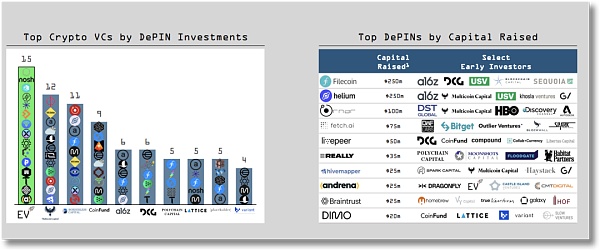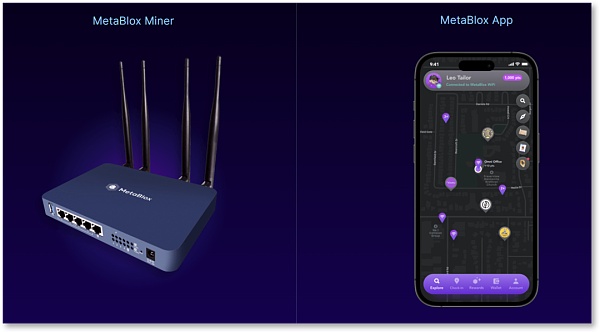Beginning in December last year, Decentralized Physical Infrastructure Networks (Decentralized Physical Infrastructure Networks) were condensed into the word "DePIN" and returned to the hot topic list in the Web3 world.
Build a data layer and incentive system based on the blockchain network, and then provide specialized software and hardware for users to contribute excess computers, networks and even energy resources, and sell them to interested parties. For individuals or businesses in need, DePIN application builders can use this to form a closed business loop.
Among more than 650 DePIN projects, the decentralized wireless network Helium, which was born in 2013 and transformed into Web3 in 2017, has attracted much attention. This project focuses on the "Internet of Things" and 5G" two popular scenarios, attracting 405,525 Helium IoT devices and 4,958 Helium 5G mobile devices to join the network.
The important basis for Helium's success is that it occupies the most popular and increasingly needed scenario of "wireless network". Internet applications and the Internet of Things all require wireless networks. , more new DePIN applications are also targeting this "most accessible" resource feature, pushing the device/node layout to the general public.
Recently, another wireless network DePIN application "MetaBlox" has built 29,009 self-owned WiFi node devices, which is 5.4 times the number of Helium 5G subnet devices. Relying on the wireless network resources contributed by these node devices, MetaBlox is providing enterprise-level WiFi roaming to users around the world.
With decentralized wireless networks, those who win the nodes win the world. MetaBlox has figured out this trick and is using low-threshold access methods, equipment discount marketing and brewing incentive plans to attract contributors to wireless network resources.
Breaking Helium’s unique new DePIN volume WiFi scene Use cases and scenarios connect the real world, DePIN looks better than DeFi, GameFi, Web3 applications such as SocialFi are easier for ordinary users to understand and experience, and they can build business models without relying on Web3's common purely financial gameplay. Capital has seen room for growth in the DePIN track, and approximately US$10 billion in venture capital has poured into the top 10 DePIN projects by market value.
Old Web3 storage facility Filecoin attracted $250 million in financing, and now Web3 wireless network facility Helium has reached the same level.

Helium raised US$250 million (picture from Messari)
Among the new DePIN unicorns, Helium is the most popular.
Helium, which entered the Web3 world in 2017, has deployed its own decentralized wireless network infrastructure and is the world's largest LoRaWAN (Long Range Wide Area Network) standard network. It supports two scenario use cases of the Internet of Things and 5G, allowing users to purchase and connect their own hotspots to build networks. Participants will receive encrypted asset incentives, and MOBILE, which was later hyped by the encrypted asset market, is the incentive token of the Helium 5G subnet.
Sharing and incentives, after the launch of Helium, some IoT and 5G software and hardware service providers quickly connected to the network. Currently, the number of Helium IoT devices is 405,525, while the number of Helium Mobile 5G devices is 4,958.
According to April 2023 data, Helium has deployed nearly 1 million hotspots (Hotspots) since its launch, covering more than 77,000 cities and towns in 192 countries and cities, forming an extensive decentralized WiFi network. The $20/month 5G telecommunications service launched in the United States late last year was out of the spotlight due to its low price.
Helium's success has also verified the effectiveness of the Web3 model in utilizing wireless network resources, and more DePIN infrastructure based on wireless networks has emerged.
On third-party DePIN data websites, wireless networks (WiFi) are becoming the most DePIN scenarios after servers. Among them, Helium ranks first in terms of attention and market value. Undoubtedly the highest, followed closely by WiFi Map and WiCrypt, and more wireless network DePINs are already on the way. The biggest feature of latecomers is that they are new enough, and an important indicator of "newness" is that the incentive token has not yet been launched.
Among the many DePIN projects in wireless network scenarios, a network called MetaBlox is on the rise. The outstanding indicator is the number of nodes. Currently, there are 29,009 MetaBlox self-service networks. With WiFi nodes, this data is 5.5 times that of Helium and continues to rise.
According to the official website of MetaBlox, MetaBlox provides free enterprise-level secure WiFi roaming services to users around the world, and its various performance indexes are comparable to or even exceed 5G mobile cellular networks. .
In today's world where Web3 applications are emerging in endlessly, MetaBlox provides a non-intrusive and secure WiFi bridge for traditional world users to migrate to Web3 without having to log in repeatedly. On the other hand, MetaBlox WiFi router and its natural geographical location provide the most direct cooperation platform and traffic channel for other DePIN infrastructure project parties and layer2 applications.
To put it simply, users can not only realize hardware miner rewards on MetaBlox WiFi routers, but also participate in network co-construction or complete other tasks through MetaBlox App Earn rewards. Since this network also serves Web3 scenarios, users will also have the opportunity to receive airdrop rewards for the SocialFi and DeFi applications it supports.
Further, we want to understand why MetaBlox, which has been deeply involved in the DeWi track for more than two years, was able to lay out 30,000 people in 98 countries in a short period of time. Multiple node devices? Can it surpass Helium and become another major Web3 WiFi provider?
Incentives for sharing WiFi MetaBlox uses both soft and hard tools
DePIN has become a major track in the field of Web3 infrastructure and applications since it was refined by Messari, a crypto-asset research institution, at the end of 2022, and wireless networks (WiFi) occupy one of the main decentralized physical foundations. Facility scene.
The reason why this scenario has attracted a large number of builders to adopt the Web3 model is that the wireless network itself requires a lot of modems, routers and other hardware. Access the network in a distributed manner.
Wireless network resources are mainly built and owned by centralized telecommunications service providers, and then sold to users, including enterprises, government agencies and ordinary users. Users are often the paying end. DePIN wireless network infrastructure such as MetaBlox attempts to allow downstream resource users to gain benefits from sharing and dilute the cost of WiFi usage.
Traditional WiFi has a series of limitations. Due to its decentralized nature, WiFi coverage is uneven and unstable, and users are unwilling to connect to WiFi in a single location. Pay, which is why it’s “free” when you connect to wireless networks in coffee shops and restaurants. But in fact, the cost of wireless networks is already included in the operating costs of physical businesses, and the speed and security of public WiFi cannot be guaranteed. .
In order to allow users to use more convenient wireless networks, the Wireless Broadband Alliance (WBA) launched the OpenRoaming framework in 2021, aiming to simplify cellular and commercial WiFi networks and roaming access between public WiFi hotspots. On the one hand, this can solve the problem of constant interruption of wireless network connections, and on the other hand, it also eliminates the need for users to register or log in frequently.
Within this framework, MetaBlox is one of the nine OpenRoaming service providers officially designated by the WBA. Others include Cisco and Boingo, which are more familiar to the public, and MetaBlox is The only team member in the Web3 field.
After spending two years, MetaBlox developed a blockchain-based architecture using a unified decentralized identity (DID) approach and verifiable credentials (VC ) system integrates small residential and commercial premises into the OpenRoaming framework (hereinafter referred to as "OR").
The DID technology adopted by MetaBlox is a new type of decentralized identifier that achieves verifiable, decentralized digital identity. DID can represent any type of subject, such as data model, real object, institutional organization, etc. The specific type is selected by its controller.
The Verifiable Credential (VC) system allows users to decide whether to share personal resources, and can also choose to share under what circumstances and in what manner.
More than 3 million OpenRoaming nodes and 29,009 self-owned nodes. This is the scale of infrastructure accumulated by the MetaBlox network so far. The overall nodes cover about 98 countries. It The purpose is to provide safe and stable WiFi roaming services to users around the world.
It is worth noting that Helium 5G in similar scenarios is only applicable to the domestic market in the United States due to frequency band restrictions, not global users. Its essence is grafted on T-moblie The above-mentioned virtual card operator (centralized card issuer) mechanism, and it is a sub-network of Helium. Further expansion requires continuous feedback from the Helium main network ecosystem. In contrast, MetaBlox WiFi's degree of decentralization and coverage are obviously more advantageous.
To promote community participation in building a Web3-style WiFi network, MetaBlox's method is to attract traffic through software and hardware at the same time.
The hardware is MetaBlox WiFi router Miner, which has now been upgraded to the second generation. It is also the node hardware that connects OR and its compatible networks. As more people connect to the OR network, the router will generate mPoints rewards. As the Utility Token (intermediate token) in MetaBlox Tokenomics, mPoints can not only be exchanged for rewards directly in the MetaBlox APP, but also gain access to other cooperative Web3 applications/services. They can also obtain the future governance of MetaBlox through staking. Token.
The online platform is the MetaBlox official App. This application supports two registration methods: Web2/Web3; after completing the registration, users can use the currently supported global WiFi roaming service for free. On the other hand, users can also participate in the MetaBlox network co-construction through the App - add their own Different amounts of mPoints rewards can be claimed on existing/public WiFi networks.

MetaBlox's mining machine router and App
Use software and hardware incentives to attract traffic In this way, MetaBlox is still accumulating the infrastructure and wireless network resources of Web3 global roaming WiFi.
MetaBlox’s first batch of routers has been sold out, and the next generation is offering an early bird price of 249 US dollars with a 50% discount; MetaBlox’s governance token is expected to be released in Launched in the second quarter of 2024, mPoints currently collected by users through route mining and participation in network co-construction are the only channel for obtaining governance tokens through staking in the future.
With the expectation of incentive value, it is easy to understand that MetaBlox can build an infrastructure scale of more than 3 million OpenRoaming nodes and 29,009 MetaBlox own nodes.
Under such infrastructure expansion, MetaBlox is expected to become another major supplier of DePIN wireless network services after Helium, and also provide WiFi providers and users with new choices. More importantly, WiFi supply under the DePIN paradigm will promote the balance of wireless network resource coverage and serve global Internet users, especially areas lacking wireless resources.
 JinseFinance
JinseFinance
 JinseFinance
JinseFinance JinseFinance
JinseFinance JinseFinance
JinseFinance JinseFinance
JinseFinance JinseFinance
JinseFinance JinseFinance
JinseFinance JinseFinance
JinseFinance JinseFinance
JinseFinance Coinlive
Coinlive  Bitcoinist
Bitcoinist